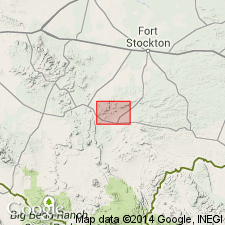
- Usage in publication:
-
- Wedin Member*
- Modifications:
-
- Named
- Dominant lithology:
-
- Limestone
- AAPG geologic province:
-
- Permian basin
Summary:
Named as a member near base of Cathedral Mountain Formation (revised) in Lenox Hills and on Dugout Mountain (vicinity of Glass Mountains, Brewster Co, TX in Permian basin). Wedin was formerly called "Second Limestone" member of Leonard Formation (King, 1931) in the Lenox Hills, and the "Fifth Limestone" member on Dugout Mountain. Cathedral Mountain Formation constitutes the bulk of the former Leonard Formation, excepting only the "First Limestone" member of King (1931), which now is called the Sullivan Peak Member of the underlying Skinner Ranch Formation (revised), and the beds on Dugout Mountain that make up the newly named Dugout Mountain Member of the Skinner Ranch. Wedin Member at type section consists of 20 ft of biohermal limestone containing abundant representatives of the brachiopod INSTITELLA. Pinches out about 1 mi east of type section, but to west forms a prominent ledge on north edge of Lenox Hills; somewhat thinner on northwest side of Dugout Mountain. Total extent is about 6.5 mi, although much of its strike lies in the covered valley between Dugout Mountain and Lenox Hills. Level of Wedin Member is marked to the northeast nearly as far as Stockton Gap by the first appearance of INSTITELLA in the Cathedral Mountain Formation. Base of the formation is not defined by the appearance of this fossil, however; the formation is a distinct lithic unit that was mapped as such (King, 1931). Permian (Leonardian) age.
Source: GNU records (USGS DDS-6; Denver GNULEX).
For more information, please contact Nancy Stamm, Geologic Names Committee Secretary.
Asterisk (*) indicates published by U.S. Geological Survey authors.
"No current usage" (†) implies that a name has been abandoned or has fallen into disuse. Former usage and, if known, replacement name given in parentheses ( ).
Slash (/) indicates name conflicts with nomenclatural guidelines (CSN, 1933; ACSN, 1961, 1970; NACSN, 1983, 2005, 2021). May be explained within brackets ([ ]).

